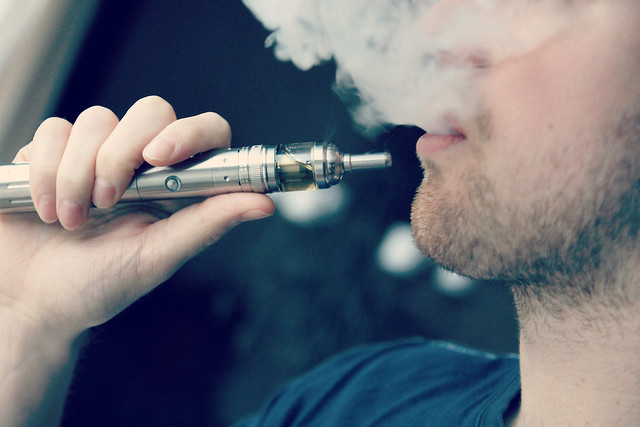Confronting a rise in youth vaping, experts strategize on actions for prevention

Public health officials have set their sights on raising the minimum legal sale age of tobacco products to 21, providing clearer labeling for cannabis products, improving youth education on cannabis and vaping and gathering more data on cannabis use.
The strategies emerged from the Nevada Public Health Cannabis and Vaping Summit, a three-day virtual gathering of research and regulatory experts, policy makers, and others convened by the attorney general’s office and state health officials. The summit has come at a pivotal moment in the state’s public health efforts, with youth vaping on a significant rise and the Cannabis Compliance Board established less than eight months ago to improve regulation of marijuana.
The approximately 200 strategies crafted by the expert speakers and summit participants will form the foundation of an action plan that will be submitted to the Division of Public and Behavioral Health (DPBH) on Feb. 15 and will not include specific goals, but instead, will provide a set of tactics segmented by the five main tracks of the summit, which focused on cannabis prevention, tobacco products, cannabis and vaping regulation, law enforcement, and special populations.
“This is intended to be a menu for you and for all of the stakeholder groups, so that you can identify needs and opportunities and use the action plan in whatever way serves you or your organization,” said Kelly Marschall, president of Social Entrepreneurs, Inc., who served as the primary moderator during the summit.
The action plan could potentially help get Nevada back on track with some of its efforts to curb youth vaping, as the state had been focused on combating the increasing uses of e-vapor products prior to the pandemic. That included joining an investigation into vape-maker JUUL over whether the company targeted youth.
Many of the strategies identified as higher priorities during the summit were focused on helping youth, including providing more mental health support for youth as a way to prevent and combat use of cannabis and vaping.
Education also remained a popular strategy for prevention of cannabis use. Some popular education strategies included improving the perception of cannabis as a harmful substance, particularly among youth, and creating clearer product labeling so that consumers can better understand dosage and potency.
With all of those strategies in mind, Marschall hopes the action plan created from the summit will provide similar changes to the ones launched out of the statewide opioid summit in 2016.
“Once we had developed that action plan, even though it was a broad set of strategies and didn't specifically have goals per se, the state was able to use that,” said Marschall. “For example, the Southern Nevada opioid advisory committee actually emerged out of that opioid summit and then took some of the action plan items in that action plan and ran with them.”
Marschall also acknowledged the level of collaboration throughout the summit and said that it should create a better product with the final action plan.
Attorney General Aaron Ford opened the summit Tuesday by calling for a strategic plan to address problems emerging from the new legal cannabis industry and vaping, which has grown in popularity in recent years.
“Nevada, along with other states across the nation, is seeing troubling trends in morbidity associated with the use of e-cigarettes, vape juice, e-liquids, such as liquid nicotine, additives, and cannabis,” said Ford. “Together we’re going to identify priorities and strategies related to legal adult use, public safety, regulation, prevention, treatment, and oversight of cannabis and vaping products in Nevada.”
Data and trends
Across multiple measures, the survey data presented at the summit showed significant increases in vaping and cannabis use among Nevada high school and middle school students.
From 2017 to 2019, the percentage of high school students who used e-vapor products at least once in the past 30 days increased from 15 to 22.5 percent. For middle school students, that number increased from 6.7 to 12 percent over the two year span.
The survey data from 2019 also revealed that Nevada eighth grade students were far more likely to have used cannabis at least once in their life compared to those at the national level, with more than 22 percent of Nevada eighth grade students reporting some lifetime cannabis use compared to only 15 percent of eighth grade students nationwide.
Data that focused on special populations revealed that high school and middle school students who had depressive symptoms or identified as lesbian, gay, or bisexual were significantly more likely to have used cannabis across all surveyed measures, including past 30-day use and frequent use.
In 2019, 6.7 percent of Nevada high school students who identified as lesbian, gay, or bisexual reported having used cannabis at least 20 times in the past 30 days, compared to only 3.5 percent of those who identified as heterosexual.
Jennifer Pearson, an assistant professor at the University of Nevada Reno, also brought up the stark differences between urban and rural students in daily use of e-vapor products.
“We also see that living in rural Nevada is related to risk of being a daily vaper in middle school and high school students,” said Pearson. “So for example, 2.4 percent of urban high school students in Nevada are daily vapers and that's compared to 8.7 percent of rural high school students.”
The data and trends presented primarily came from the 2017 and 2019 Youth Risk Behavior Surveys (YRBS), which used data collected by the Centers for Disease Control and UNR from a random sample of high schools and middle schools across the state. The data was also weighted at the state and regional levels based on sex, race and ethnicity, and grade level.
Despite the emphasis on the data already being used, strategies also emphasized a need to collect more data. Many summit participants voted for and discussed strategies that focused on completing more research and making more decisions based on available data.
The state is already taking steps in this direction. During the opening session of the summit, Ford announced that Nevada now has a cannabis epidemiologist to assist in collecting data. Ford also said this data collection would focus on the trends such as an increase in lung injuries linked with the use of nicotine and cannabis products.
Regulation
Speakers at the virtual summit also discussed the current regulations and the future goals and challenges for vaping products. In the 2021 legislative session, advocates are looking to propose raising the minimum legal sale age of tobacco products from 18 to 21.
Public health experts also aim to protect the gains achieved in 2019, particularly to defeat the effort to repeal how vapor products are taxed as “other tobacco products” and preserve vaping prevention and control funding.
“Buckle up, it’s going to be a little bit of a wild ride,” said Democratic state Sen. Julia Ratti, chair of the state Senate Health and Human Services Committee. “Because there's just an awful lot of uncertainty and fluidity when it comes to this budget and we're going to have to start the process by making the cuts and assuming that we're not going to have the revenue of a recovering economy.”
The Cannabis Compliance Board (CCB) also faces some uncertainty in the face of some of the statewide budget cuts.
During the summit, CCB board member Riana Durrett said the agency is currently preparing a report on approaches to handling the illegal market. Durrett thinks the report could prompt legislative action during the upcoming session.
Although budget cuts could restrain any new action taken to regulate the illegal cannabis market in Nevada, there were strategies introduced at the summit to improve regulation of the legal cannabis market.
One was to ensure clearer product labeling. Many experts at the summit emphasized that there is a general lack of perception about the harmful effects of cannabis, and some said that creating more consistent product labeling and including more product warnings could help raise awareness.
The CCB already has a number of regulations in place aimed at product marketing and packaging, and many of these regulations are intended to prevent youth use of cannabis products.
Under existing rules, advertising may not be false or misleading, depict actual consumption or depict someone who appears to be under 21 or be placed near a school, playground, or sporting event. Pictures of toys, cartoons, mascots or anything appealing to children is also not allowed.
Packaging must be childproof and may not be packaged or marketed as candy.
Aside from advertising regulation, the CCB also extensively monitors product quality from “seed to sale,” as explained in the summit. The board examines and tracks the growth of the cannabis plant and the pesticides used to treat the plant. It also reviews all the ingredients and verifies that everything is safe for ingestion.
Even with this strict regulation in place, there is still an extensive illegal cannabis market in Nevada, and youth cannabis use is on the rise.
After the summit’s action plan is submitted to the DPBH in February, the Legislature and other stakeholders from the event will have an opportunity to act on the recommended strategies.

